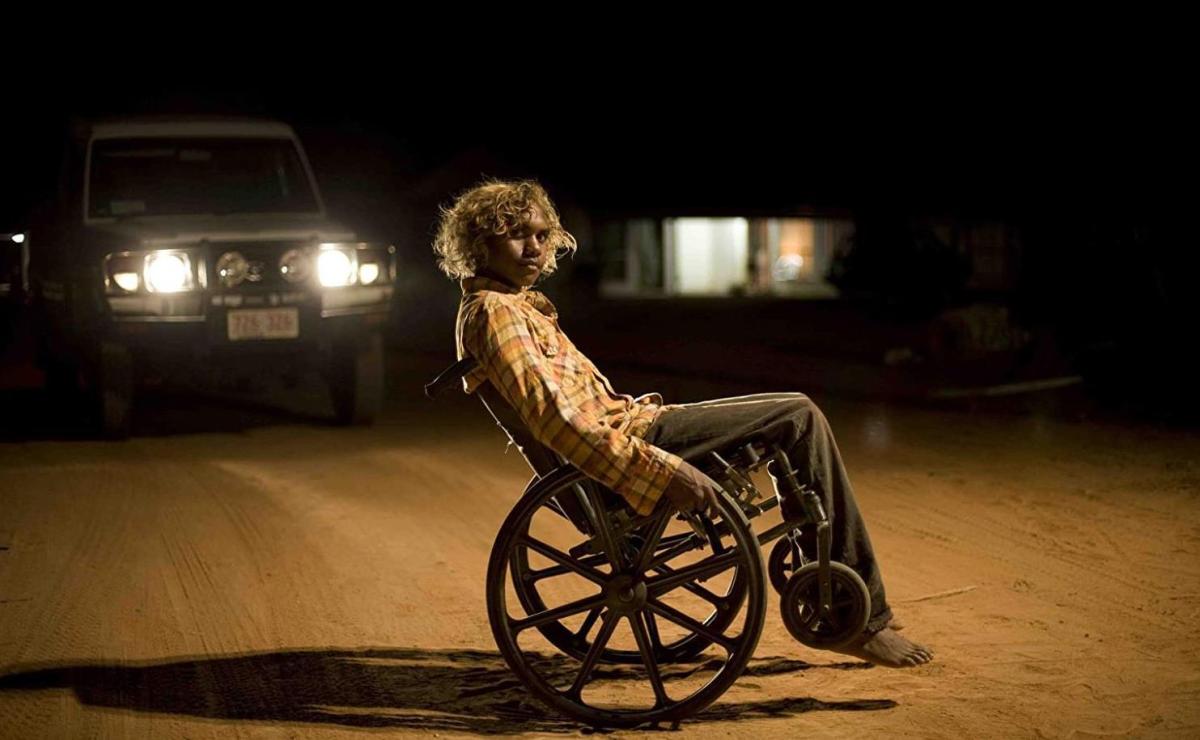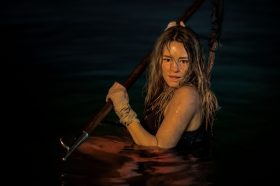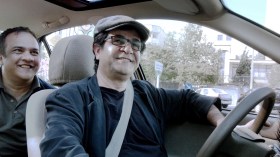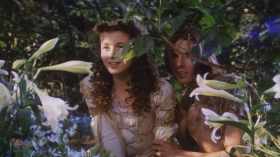Nearly thirty years after the creation of SBS, the role of diversity in our screen media is becoming increasingly bizarre. On the ground, our society has become steadily more multicultural, as succeeding waves of migrants establish themselves, and their children move confidently into the wider world.
Ask any teacher about the changes in schools. Sit on public transport for a day. Look at the faces in any large workplace. Check the stamps on the passports of young travellers venturing beyond Australia. We live in a multicultural world.
But commercial television, and to a significant extent the ABC, still pretends Australia is a monoscopic, white bread society. SBS, starved under the Howard government, has not been rescued by the Labor Party, and grapples with acute financial distress.
This bland vision of Australia doesn’t reflect the audience. It avoids wonderful opportunities for story, tension and humour. It hides from the simple fact that some of our most dynamic drama on television comes from SBS, which is focused on intercultural stories. Think of East-West 101, The Circuit and Remote Area Nurse.
Most remarkable of all, Australian cinema at the moment is full of multicultural stories. Balibo, Cedar Boys, Samson & Delilah, Mao’s Last Dancer, The Combination, Stone Bros, Two Fists One Heart and even Australia itself all revolve around cultural identity.
Ana Tiwary and Natalie Millar are creating a website to create discussion about the current dilemmas of multiculturalism on screen. The forum is here, or here, via Facebook.
Ana Tiwary is the founder/director of WIFT’s Media Mentorship for Women Program, and is a producer and director who has worked around the world, from Nat Geo to Bollywood. Natalie a Sydney production manager, and is also undertaking an MA Research project in Indian film at AFTRS.
Together, they have written this background document for the website.
——
The Diversity Dilemma: Some reflections from Ana Tiwary and Natalie Millar.
It’s strange that such a well-worn topic as diversity and multiculturalism on our screens should still be a sensitive issue that only the “brave” will tackle.
Yet we are asking the same questions which have been asked for decades, and we are met with trepidation, frustration and occasional despair.
In our screen and media culture, is diversity and ethnic mixing – including Indigenous Australians – now a normal, everyday part of life? Or is it still seen as a “threat” to a “mainstream” Australian culture?
Diversity Dynamics in Society and on Screen
Diversity is a reality, it is dynamic and growing around the world as more people are migrating than ever before. Closing our eyes and living in denial will not make it go away. The sooner we accept diversity as a positive force rather than a problem, the sooner we will be able to recognize and use it’s potential.
In a post 9/11 world the threat of violence arising from ethnic tensions, fear and suspicion caused by popular alienation is arguably greater than ever before, and the recent Indian student protests reminded us of what happens when minority voices are continually ignored. This week news about the alleged involvement of four Australian citizens with Somali and Lebanese origins in the Melbourne terror plot, is the extreme to which social exclusion can take us.
What has happened to the great idealism we felt 20 years ago as we envisioned a multicultural Australia, leaving our assimilationist and “White Australia Policy” days behind us? It’s the sad truth that you may see more diversity on one train trip in Sydney than you would on a whole year of your commercial free-to-air TV screen.
Tony Ayres told us that over the 20 years he has been in the industry little progress has been made and “the discourse around the issue remains the same”. Why are we still stuck in this situation and what will it take for the mainstream media establishment to remedy it?
After all, it makes both social and financial sense to tap into the large part of our population being neglected by our small screen characterisations. Cultural value and commercial success need not be mutually exclusive.
In Black and White
Australian culture is often painted in terms of either/or indigenous and white cultures. But what percentage of people living here at this moment actually falls neatly into these two categories? Many of us have much more complicated ethnic and cultural identities than that. Can we accept the “Anglo Aussie” culture as but one face of our diverse identity? We can absolutely embrace the core values that have come to define “Australian” such as fairness, equality, mateship, humour and a relaxed approach, while letting go of a stereotyped Aussie image. We think it’s about time we get real and represent ourselves as we really are.
Film director Helen Goritsas, who is working on a cross-cultural comedy Alex & Eve believes that “It is important that we make Australian films about all Australians. I strongly believe it is crucial that we are able to express through our own cinema our own stories, stories that are at heart truly Australian and voice the concerns of our communities.
Socio-political satire offers a wonderful vehicle through which to communicate difficult issues such as these. It is a means by which we are able to hold up a mirror to ourselves and to our society and really look. In ‘Alex & Eve’ the stereotypes depicted serve to emphasise the central theme of the film, generational-frozen values. In a cheeky way these barriers are challenged and in so doing we hope to reduce the ignorance and misunderstandings that currently surround us about Greek, Lebanese as well as mainstream Australian culture.”
No drama in Drama
We can celebrate some diversity in the area of feature film with examples of Australian box-office success for films like Samson & Delilah and The Combination in this year alone. And with Cedar Boys currently on our screens and Mao’s Last Dancer to look forward to soon, comparatively cross-cultural stories seem to be faring better than mainstream films.
The popularity of these films is a clear sign that the population wants to see diverse representations and authentic stories. Will our mainstream TV networks take this as a hint and review their programming to reflect this evolving audience taste?
And we thankfully still have SBS, but the low funding sends a clear message to the ethnic communities that the Government is not serious about social cohesion. If the SBS has to rely on advertising and ratings, it makes it more difficult for it to be committed to presenting diverse points of view and multiculturally aware stories. In the long run this will mean that SBS will loose its distinctive multicultural character.
But what about the mainstream top-raters on TV? Can we honestly say that we’re seeing healthy degrees of colour-blind casting and real-world diversity being reflected at us from our commercial free to air channels? Or is it possible that we’re slipping deeper into a segregation of our popular TV audience down ethnic lines as we all too often fail to break out of stereotyped “Anglo-Aussie” character moulds?
Down at the local grocery store Greek cable TV plays in the background, and our South Asian friends have switched off free-to-air in favour of expensive international satellite TV channels because they feel alienated by the mainstream fare. The Head of Programming at SBS, Dr. Jane Roscoe says “At SBS we are not driven by ratings, but guided by our Charter. The big challenge is really to represent the contemporary face of Australia in all it’s diversity. That means moving away from obvious stereotypes and recognising that there is more than one way to be ‘Italian’ or ‘Greek’ or Chinese’. The biggest challenge is in being able to serve all of these specific communities, whilst still be accessible and engaging to the broader audience.”
Conflict & Creativity
It’s a bit of an Australian myth that we shy away from conflict and avoid confrontation, and it is often all too much of a reality. But then isn’t enjoying difference and conflict resolution at the heart of the creative force that drives not just story, but growth, learning and social development? There is no doubt that much can be gained both as creative professionals and as a society by choosing to engage with diversity in the stories we tell. In this way we can also develop a more real and inclusive picture of the everyday fabric of Australian life on our screens and contribute to the development of a more mature Australian culture and society that can embrace diversity and become richer for it.
Talking about how to deal with diversity in the scriptwriting stage, script-coach Karel Segers says “Cultural stereotyping is not needed in stories as long as the writer signals the function of the character to the audience using the techniques of archetyping. People from all cultures can relate to archetypes”.
Karel adds, “I feel that we have been preaching to the converted: films with an accurate representation of cultural diversity are rarely told in a way the mainstream audience understands them. I find that both filmmakers and policy makers have taken an elitist position by encouraging this type of cinema.”
Everyday Diversity
In everyday life Australia is made up of a very diverse mix and the majority of us accept this as a reality; a recent survey revealing 93% of Australians think we are in fact a multicultural society. In 2008 over a quarter of Australians were born overseas and more than one third have either one or both parents born outside the country. People from around 200 countries have made this country their home and over 200 languages are spoken here.
However, compared to this mix in other sectors, employment in the audiovisual industries continues to have a much lower representation of this ethnic diversity. Tony Ayres noted that we do see some of our diversity reflected in the mix of participants cast on reality TV shows, demonstrating that it’s not for a lack of talent and interest in participating in screen culture that we’re missing this diverse mix particularly in TV drama series.
One has to question – is something happening in the creative and commissioning processes that are ethnically selective or worse, actively exclusive? Believing we are a multicultural society is not enough in itself. Belief in the value of it is something much more.
Preeti Kannan, a media professional who recently migrated from UAE says “The truth is that multiculturalism exists here. However, it just exists. It hasn’t been integrated and included not just in the media but elsewhere too… Diversity is conspicuously inconspicuous in the Aussie media, politics, university faculties… just about everywhere.”
No Soft Solutions
An 11-year study into Racism in Australia by a collaboration of Australian universities found that 85 per cent of Australians acknowledge racial prejudice occurs in the nation with one in five claiming to be a victim of racist verbal abuse or related incidents. This should be reason enough for us to get serious about redefining what ‘Australian’ content means.
After 20 years there is still a long way to go in terms of diversity in Australian screen, especially on the small screen. It would seem that if we are to achieve a living, vital and diverse screen culture, we need some renewed policy intervention in the commercial sector.
We can again look at creating initiatives that encourage diverse participation in the mainstream industry. Community inititiatives such as ICE (Inter-cultural Exchange) which operates in Western Sydney for example, are working closely with ethnic communities but how much of their work actually reaches the mainstream audience?
Dr. Jane Roscoe says that “I think it’s also important that we identify new talent within various communities and where possible work with them to get their stories to air. The more diversity in our content producers, the more perspectives and points of view we’ll get in our television and online content. SBS is committed to screening stories that reflect the changing face of Australia, and part of this is nurturing creative talent that can do this.” The other option is a top down approach. Perhaps we need to consider measures that encourage commissioning in commercial networks and to consider diversity, and not just “leave it to SBS”.
Since majority rules, in any Democracy it is difficult to for ethnic minorities to feel a sense of belonging to their adopted land let alone get their voices heard. Having said that Australia has the potential to turn this around and create an inclusive and rich society without having to give up its national identity. This is where the Australian screen industry can play a powerful positive role in bringing about change.
Tony Ayres comments “I think that we need a comprehensive study of cultural diversity on our screens which factors in what has changed and what hasn’t, and government has to decide whether cultural diversity is genuinely important to Australian cultural identity, and therefore Australian culture… This may sound dogmatic, but it doesn’t have to be – it becomes one benchmark alongside many others… After being around this industry for the last twenty years, and watching the same arguments about our screen content pop up year in, year out, I feel that the “softly, softly” approach won’t ever work.”
We think that a first step in this process is getting discussion re-opened around this topic amongst ourselves and to this end we’ve created a forum.
We’d love to hear your comments so please visit the Facebook group ‘Diversity in Australian Media’ and leave your comments: here.
If you are in Sydney you could also participate in the ‘Diversity Debate’ hosted by Women in Film and Television NSW at AFTRS on 16 September 2009.





